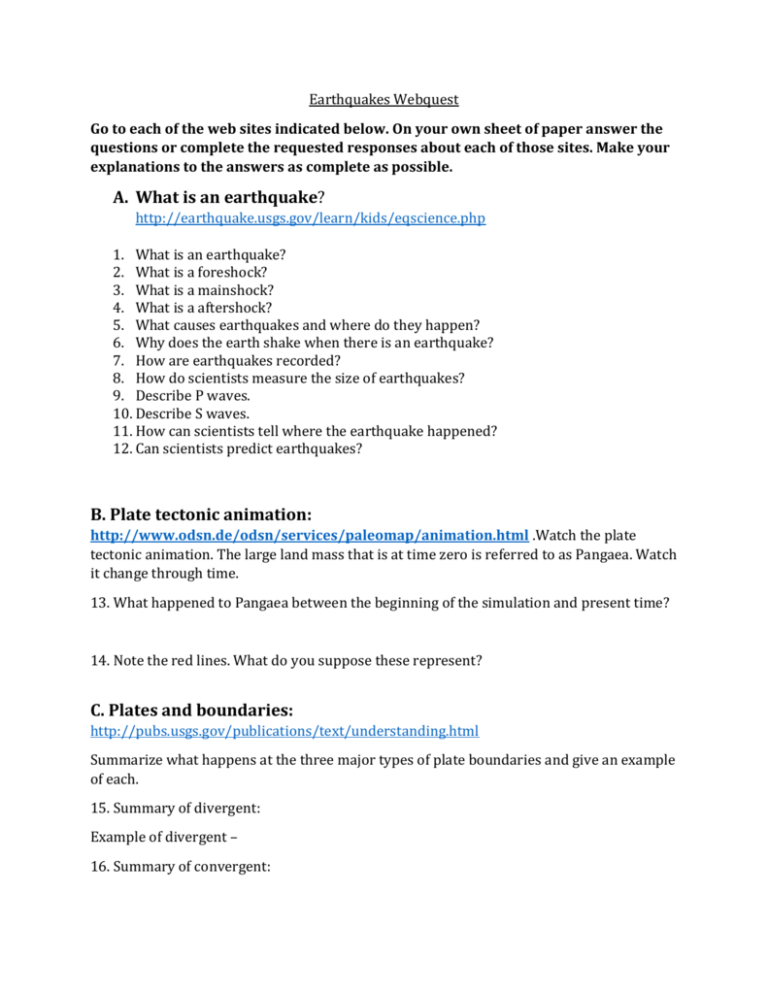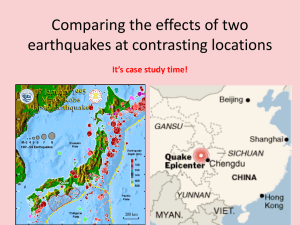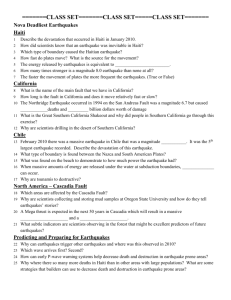Earthquake Webquest
advertisement

Earthquakes Webquest Go to each of the web sites indicated below. On your own sheet of paper answer the questions or complete the requested responses about each of those sites. Make your explanations to the answers as complete as possible. A. What is an earthquake? http://earthquake.usgs.gov/learn/kids/eqscience.php 1. What is an earthquake? 2. What is a foreshock? 3. What is a mainshock? 4. What is a aftershock? 5. What causes earthquakes and where do they happen? 6. Why does the earth shake when there is an earthquake? 7. How are earthquakes recorded? 8. How do scientists measure the size of earthquakes? 9. Describe P waves. 10. Describe S waves. 11. How can scientists tell where the earthquake happened? 12. Can scientists predict earthquakes? B. Plate tectonic animation: http://www.odsn.de/odsn/services/paleomap/animation.html .Watch the plate tectonic animation. The large land mass that is at time zero is referred to as Pangaea. Watch it change through time. 13. What happened to Pangaea between the beginning of the simulation and present time? 14. Note the red lines. What do you suppose these represent? C. Plates and boundaries: http://pubs.usgs.gov/publications/text/understanding.html Summarize what happens at the three major types of plate boundaries and give an example of each. 15. Summary of divergent: Example of divergent – 16. Summary of convergent: Example of convergent17. Summary of transform: Example of transform- D. Fault Boundaries http://www.geography4kids.com/files/earth_faulting.html 18. What happens when two plates meet? 19. Describe folding: 20. Describe faulting: 21. What are dip slips? 22. What is a strike slip? E. Richter magnitude: http://crack.seismo.unr.edu/ftp/pub/louie/class/100/magnitude.html 23. The Richter Scale is one way to measure the magnitude of an earthquake. Describe the result of an earthquake with a magnitude under level 6 on the Richter Scale. 24. At what level can damage across several hundred kilometers occur? F. Earthquake History: On this day in Earthquake History…. http://earthquake.usgs.gov/learn/today/ 25. Look up today’s date. What happened on this day in Earthquake History? 26. Look up your birthday. Summarize what happened in Earthquake History on your birthday (even if it wasn’t the same year). G. Latest Earthquakes http://earthquake.usgs.gov/ You will click on the above link "Checking Current Earthquakes," Then click on the "Latest Earthquakes" Map. On the left side you will see a list of the latest earthquakes in the world that have been 2.5 magnitude or higher 27. List all the earthquakes that have occured today; List; the date Magnitude Location Zoom out on the map and see where these earthquakes have taken place (orange dots) 29. Where have most taken place? 30. Where was the most recent earthquake in the United States? H. Savage Earth - PBS online: http://www.thirteen.org/savageearth/index.html 31. Click on “The Restless Planet: Earthquakes”. Scroll down to the three green boxes showing the surface wave, primary wave and secondary wave animations. Click on the start button of each of these and summarize the wave action for each. surface wave: primary wave: secondary wave: I. Earthquake Trivia: Did you know…?? http://earthquake.usgs.gov/learn/facts.php Go to the link above and search out the answers to the following trivia questions. 32. What is the largest recorded earthquake in the world? 33. What is the largest recorded earthquake in the United States? 34. How many detectable earthquakes happen each year? How many actually cause damage? 35. How many earthquakes does southern California have each year? 36. What fault is responsible for creating earthquakes in the central U.S.? Explain why these earthquakes seem much larger in the Midwest compared to those in the West. 38. Which two states have the least number of earthquakes? Which state has the most earthquakes? 39. Can we hear earthquakes? Why or why not?









